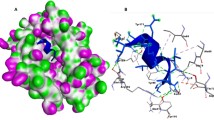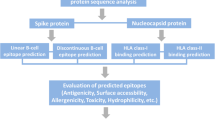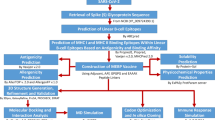Abstract
The outbreak of novel SARS-CoV-2 virion has wreaked havoc with a high prevalence of respiratory illness and high transmission due to a vague understanding of the viral antigenicity, augmenting the dire challenge to public health globally. This viral member necessitates the expansion of diagnostic and therapeutic tools to track its transmission and confront it through vaccine development. Therefore, prophylactic strategies are mandatory. Virulent spike proteins can be the most desirable candidate for the computational design of vaccines targeting SARS-CoV-2, followed by the meteoric development of immune epitopes. Spike protein was characterized using existing bioinformatics tools with a unique roadmap related to the immunological profile of SARS-CoV-2 to predict immunogenic virulence epitopes based on antigenicity, allergenicity, toxicity, immunogenicity, and population coverage. Applying in silico approaches, a set of twenty-four B lymphocyte-based epitopes and forty-six T lymphocyte-based epitopes were selected. The predicted epitopes were evaluated for their intrinsic properties. The physico-chemical characterization of epitopes qualifies them for further in vitro and in vivo analysis and pre-requisite vaccine development. This study presents a set of screened epitopes that bind to HLA-specific allelic proteins and can be employed for designing a peptide vaccine construct against SARS-CoV-2 that will confer vaccine-induced protective immunity due to its structural stability.













Similar content being viewed by others
References
Saha R, Ghosh P, Burra VP. Designing a next generation multi-epitope based peptide vaccine candidate against SARS-CoV-2 using computational approaches. Biotech. 2021;11:47. https://doi.org/10.1007/s13205-020-02574-x.
Finco O, Rappuoli R, Smith KA. Designing vaccines for the twenty-first century society. 2014. www.frontiersin.org
Enayatkhani M, Hasaniazad M, Faezi S, Gouklani H, Davoodian P, Ahmadi N, et al. Reverse vaccinology approach to design a novel multi-epitope vaccine candidate against COVID-19: an in silico study. J Biomol Struct Dyn. 2021;39:2857–72. https://doi.org/10.1080/07391102.2020.1756411.
Patronov A, Doytchinova I. T-cell epitope vaccine design by immunoinformatics. Open Biol. 2013. https://doi.org/10.1098/rsob.120139.
Ahammad I, Lira SS. Designing a novel mRNA vaccine against SARS-CoV-2: an immunoinformatics approach. Int J Biol Macromol. 2020;162:820–37. https://doi.org/10.1016/j.ijbiomac.2020.06.213.
Noorimotlagh Z, Karami C, Mirzaee SA, Kaffashian M, Mami S, Azizi M. Immune and bioinformatics identification of T cell and B cell epitopes in the protein structure of SARS-CoV-2: a systematic review. Int Immunopharmacol. 2020;86:106738. https://doi.org/10.1016/j.intimp.2020.106738.
COVID-19 vaccine tracker and landscape. https://www.who.int/publications/m/item/draft-landscape-of-covid-19-candidate-vaccines
Dunn-Walters DK, Gray JJ, Chen K, Nielsen M, Dk M, Marcatili P, et al. Antibody specific B-cell epitope predictions: leveraging information from antibody-antigen protein complexes. Front Immunol. 2019;10:298.
Blanco E, Ferrari M. Emerging nanotherapeutic strategies in breast cancer. Breast Church Livingstone. 2014;23:10–8.
Li W, Joshi MD, Singhania S, Ramsey KH, Murthy AK. Peptide vaccine: progress and challenges. Vaccines. 2014;2:515–36.
Qadir A, Riaz M, Saeed M, Shahzad-ul-Hussan S. Potential targets for therapeutic intervention and structure based vaccine design against Zika virus. Eur J Med Chem. 2018;156:444–60. https://doi.org/10.1016/j.ejmech.2018.07.014.
Bowden TA, Crispin M, Harvey DJ, Aricescu AR, Grimes JM, Jones EY, et al. Crystal structure and carbohydrate analysis of nipah virus attachment glycoprotein: a template for antiviral and vaccine design. J Virol. 2008;82:11628–36.
Jabbar B, Rafique S, Salo-Ahen OMH, Ali A, Munir M, Idrees M, et al. Antigenic peptide prediction from E6 and E7 oncoproteins of HPV types 16 and 18 for therapeutic vaccine design using immunoinformatics and MD simulation analysis. Front Immunol. 2018;9:3000.
Ye ZW, Yuan S, Yuen KS, Fung SY, Chan CP, Jin DY. Zoonotic origins of human coronaviruses. Int J Biol Sci. 2020;16:1686–97.
Abdelmageed MI, Abdelmoneim AH, Mustafa MI, Elfadol NM, Murshed NS, Shantier SW, et al. Design of a multiepitope-based peptide vaccine against the E protein of human COVID-19: an immunoinformatics approach. BioMed Res Int. 2020. https://doi.org/10.1155/2020/2683286.
Crooke SN, Ovsyannikova IG, Kennedy RB, Poland GA. Immunoinformatic identification of B cell and T cell epitopes in the SARS-CoV-2 proteome. bioRxiv. 2020
Gao H, Yao H, Yang S, Li L. From SARS to MERS: evidence and speculation. Front Med. 2016;10:377–82.
Greenbaum JA, Andersen PH, Blythe M, Bui HH, Cachau RE, Crowe J, et al. Towards a consensus on datasets and evaluation metrics for developing B-cell epitope prediction tools. J Mol Recognit. 2007;20:75–82.
Behmard E, Soleymani B, Najafi A, Barzegari E. Immunoinformatic design of a COVID-19 subunit vaccine using entire structural immunogenic epitopes of SARS-CoV-2. Sci Rep. 2020;10:1–28.
Yang Z, Bogdan P, Nazarian S. An in silico deep learning approach to multi-epitope vaccine design: a SARS-CoV-2 case study. Sci Rep. 2021;11:1–21. https://doi.org/10.1038/s41598-021-81749-9.
Rahman MS, Hoque MN, Islam MR, Akter S, Ul Alam ASMR, Siddique MA, et al. Epitope-based chimeric peptide vaccine design against S, M and e proteins of SARS-CoV-2, the etiologic agent of COVID-19 pandemic: an in silico approach. PeerJ. 2020;8:e9572.
Gangaev A, Ketelaars SLC, Isaeva OI, Patiwael S, Dopler A, Hoefakker K, et al. Identification and characterization of a SARS-CoV-2 specific CD8+ T cell response with immunodominant features. Nat Commun. 2021;12:2593.
Creech CB, Walker SC, Samuels RJ. SARS-CoV-2 vaccines. JAMA. 2021;325:1318–20.
Rauta PR, Ashe S, Nayak D, Nayak B. In silico identification of outer membrane protein (Omp) and subunit vaccine design against pathogenic Vibrio cholerae. Comput Biol Chem. 2016;65:61–8. https://doi.org/10.1016/j.compbiolchem.2016.10.004.
Pedersen SF, Ho Y-C. SARS-CoV-2: a storm is raging. J Clin Invest. 2020;130:2202–5. https://doi.org/10.1172/JCI137647.
Macri C, Dumont C, Johnston AP, Mintern JD. Targeting dendritic cells: a promising strategy to improve vaccine effectiveness. Clin Transl Immunol. 2016;5:e66. https://doi.org/10.1038/cti.2016.6.
Kreer C, Gruell H, Mora T, Walczak AM, Klein F. Exploiting B cell receptor analyses to inform on HIV-1 vaccination strategies. Vaccines. 2020;8:1–19.
Shang J, Wan Y, Luo C, Ye G, Geng Q, Auerbach A, et al. Cell entry mechanisms of SARS-CoV-2. Proc Natl Acad Sci. 2020;117:11727–34.
Meyers LM, Gutiérrez AH, Boyle CM, Terry F, McGonnigal BG, Salazar A, et al. Highly conserved, non-human-like, and cross-reactive SARS-CoV-2 T cell epitopes for COVID-19 vaccine design and validation. npj Vaccines. 2021;6:1–14. https://doi.org/10.1038/s41541-021-00331-6.
Jurewicz MM, Stern LJ. Class II MHC antigen processing in immune tolerance and inflammation. Immunogenetics. 2019. https://doi.org/10.1007/s00251-018-1095-x.
Role of MHC Gene Products in Immune Regulation on JSTOR [Internet]. [cited 2021 Sep 3]. https://www.jstor.org/stable/1685781?seq=1#metadata_info_tab_contents
Kar T, Narsaria U, Basak S, Deb D, Castiglione F, Mueller DM, et al. A candidate multi-epitope vaccine against SARS-CoV-2. Sci Rep. 2020. https://doi.org/10.1038/s41598-020-67749-1.
Flower DR, Doytchinova I, Zaharieva N, Dimitrov I. Immunogenicity prediction by VaxiJen: a ten year overview. J Proteomics Bioinform. 2017;10:298–310.
Saha S, Raghava GPS. Prediction methods for B-cell epitopes. Methods Mol Biol. 2007;409:387–94.
Paul S, Sidney J, Sette A, Peters B. TepiTool: a pipeline for computational prediction of T cell epitope candidates. Curr Protoc Immunol. 2016;2016:18.19.1-18.19.24.
Jensen KK, Andreatta M, Marcatili P, Buus S, Greenbaum JA, Yan Z, et al. Improved methods for predicting peptide binding affinity to MHC class II molecules. Immunology. 2018;154:394–406.
Trolle T, McMurtrey CP, Sidney J, Bardet W, Osborn SC, Kaever T, et al. The length distribution of class I-restricted T cell epitopes is determined by both peptide supply and MHC allele-specific binding preference. J Immunol. 2016;196:1480–7.
Dhanda SK, Vaughan K, Schulten V, Grifoni A, Weiskopf D, Sidney J, et al. Development of a novel clustering tool for linear peptide sequences. Immunology. 2018;155:331–45.
Dimitrov I, Flower DR, Doytchinova I. AllerTOP-a server for in silico prediction of allergens [Internet]. 2011. http://www.biomedcentral.com/1471-2105/14/S6/S4
Bui HH, Sidney J, Dinh K, Southwood S, Newman MJ, Sette A. Predicting population coverage of T-cell epitope-based diagnostics and vaccines. BMC Bioinform. 2006;7:1–5.
Wilkins MR, Gasteiger E, Bairoch A, Sanchez JC, Williams KL, Appel RD, et al. Protein identification and analysis tools in the ExPASy server. Methods Mol Biol. 1999;112:531–52.
Geourjon C, Deléage G. Sopma: significant improvements in protein secondary structure prediction by consensus prediction from multiple alignments. Bioinformatics. 1995;11:681–4.
Schrödinger at the 236th ACS National Meeting & Exposition, Philadelphia, PA, August 17–21 | Schrödinger [Internet]. https://www.schrodinger.com/conferences-meetings/schrodinger-236th-acs-national-meeting-exposition-philadelphia-pa-august-17-21
Gupta S, Singh AK, Kushwaha P, Prajapati KS, Shuaib M, Senapati S, et al. Identification of potential natural inhibitors of SARS-CoV2 main protease by molecular docking and simulation studies. https://www.tandfonline.com/action/journalInformation?journalCode=tbsd20
Xue LC, Ao J, Rodrigues P, Kastritis PL, Bonvin AM, Vangone A. Structural bioinformatics PRODIGY: a web server for predicting the binding affinity of protein-protein complexes. http://milou.science.uu.nl/services/PRODIGY.
Drug allergy: an updated practice parameter. Ann Allergy Asthma Immunol [Internet]. Ann Allergy Asthma Immunol; 2010;105. https://pubmed.ncbi.nlm.nih.gov/20934625/
Altmann DM, Boyton RJ, Beale R. Immunity to SARS-CoV-2 variants of concern. Science. 2021;371:1103–4.
Tran HN, Le GT, Nguyen DT, Juang RS, Rinklebe J, Bhatnagar A, et al. SARS-CoV-2 coronavirus in water and wastewater: a critical review about presence and concern. Environ Res. 2021;193:110265.
Enjuanes L, Zuñiga S, Castaño-Rodriguez C, Gutierrez-Alvarez J, Canton J, Sola I. Molecular basis of coronavirus virulence and vaccine development. Adv Virus Res Academic Press. 2016;96:245–86.
Arab-Zozani M, Hassanipour S. Features and limitations of LitCovid hub for quick access to literature about COVID-19. Balkan Med J. 2020;37:231.
Ahmed SF, Quadeer AA, McKay MR. Preliminary identification of potential vaccine targets for the COVID-19 coronavirus (SARS-CoV-2) based on SARS-CoV immunological studies. Viruses. 2020;12:254.
Walls AC, Park YJ, Tortorici MA, Wall A, McGuire AT, Veesler D. Structure, function, and antigenicity of the SARS-CoV-2 spike glycoprotein. Cell Cell Press. 2020;181:281-292.e6.
Wang J, Peng Y, Xu H, Cui Z, Williams RO. The COVID-19 vaccine race: challenges and opportunities in vaccine formulation. AAPS PharmSciTech. 2020;21:1–12. https://doi.org/10.1208/s12249-020-01744-7.
Bhattacharya M, Sharma AR, Patra P, Ghosh P, Sharma G, Patra BC, et al. Development of epitope-based peptide vaccine against novel coronavirus 2019 (SARS-COV-2): immunoinformatics approach. J Med Virol. 2020;92:618–31. https://doi.org/10.1002/jmv.25736.
Kharisma VD, Ansori ANM. Construction of epitope-based peptide vaccine against SARS-CoV-2: immunoinformatics study. J Pure Appl Microbiol. 2020;14:999–1005.
Samad A, Ahammad F, Nain Z, Alam R, Imon RR, Hasan M, et al. Designing a multi-epitope vaccine against SARS-CoV-2: an immunoinformatics approach. J Biomol Struct Dyn. 2020;0:1–17. https://doi.org/10.1080/07391102.2020.1792347.
Panda PK, Arul MN, Patel P, Verma SK, Luo W, Rubahn HG, et al. Structure-based drug designing and immunoinformatics approach for SARS-CoV-2. Sci Adv. 2020;6:1–15.
Prachar M, Justesen S, Steen-Jensen DB, Thorgrimsen S, Jurgons E, Winther O, et al. Abstract PO-046: assessment of COVID-19 vaccine candidates: prediction and validation of 174 SARS-CoV-2 epitopes. 2020;PO-046-PO-046
Sarkar B, Ullah MA, Johora FT, Taniya MA, Araf Y. Immunoinformatics-guided designing of epitope-based subunit vaccines against the SARS Coronavirus-2 (SARS-CoV-2). Immunobiology. 2020;225:151955. https://doi.org/10.1016/j.imbio.2020.151955.
Costa JG, Faccendini PL, Sferco SJ, Lagier CM, Marcipar IS. Evaluation and comparison of the ability of online available prediction programs to predict true linear B-cell epitopes. Sharjah: Bentham Science Publishers; 2013.
Karosiene E, Lundegaard C, Lund O, Nielsen M. NetMHCcons: a consensus method for the major histocompatibility complex class I predictions. www.cbs.dtu
Peters B, Bulik S, Tampe R, van Endert PM, Holzhütter H-G. Identifying MHC class I epitopes by predicting the TAP transport efficiency of epitope precursors. J Immunol. 2003;171:1741–9.
Kiyotani K, Toyoshima Y, Nemoto K, Nakamura Y. Bioinformatic prediction of potential T cell epitopes for SARS-Cov-2. J Hum Genet. 2020;65:569–75. https://doi.org/10.1038/s10038-020-0771-5.
Poran A, Harjanto D, Malloy M, Rooney MS, Srinivasan L, Gaynor RB. Sequence-based prediction of vaccine targets for inducing T cell responses to SARS-CoV-2 utilizing the bioinformatics predictor RECON. bioRxiv. 2020;1–30
Youngblood B, Hale JS, Kissick HT, Ahn E, Xu X, Wieland A, et al. Effector CD8 T cells dedifferentiate into long-lived memory cells. Nat. 2017;552:404–9.
Guermonprez P, Valladeau J, Zitvogel L, Théry C, Amigorena S. Antigen presentation and T cell stimulation by dendritic cells. Annu Rev Immunol. 2002;20:621–67.
Hale JS, Youngblood B, Latner DR, Mohammed AUR, Ye L, Akondy RS, et al. Distinct memory CD4+ T cells with commitment to T follicular Helper- and T Helper 1-cell lineages are generated after acute viral infection. Immunity Cell Press. 2013;38:805–17.
Chen HZ, Tang LL, Yu XL, Zhou J, Chang YF, Wu X. Bioinformatics analysis of epitope-based vaccine design against the novel SARS-CoV-2. Infect Dis Poverty. 2020;9:1–10.
Singh A, Thakur M, Sharma LK, Chandra K. Designing a multi-epitope peptide based vaccine against SARS-CoV-2. Sci Rep. 2020;10:16219.
Smit LAM, Heederik D, Doekes G, Blom C, Van Zweden I, Wouters IM. Exposure-response analysis of allergy and respiratory symptoms in endotoxin-exposed adults. Eur Respir J. 2008;31:1241–8.
Grifoni A, Sidney J, Zhang Y, Scheuermann RH, Peters B, Sette A. A sequence homology and bioinformatic approach can predict candidate targets for immune responses to SARS-CoV-2. Cell Host Microbe Cell Press. 2020;27:671-680.e2.
Medzhitov R, Janeway CA. Innate immunity: impact on the adaptive immune response. Curr Opin Immunol. 1997;9:4–9.
Sever W, Garg VK, Avashthi H, Tiwari A, Jain A, Ramkete PW, et al. MFPPI-multi FASTA ProtParam interface. Open access. 2016;12:74.
Lee CH, Koohy H, Wilkinson K, de Palma R, Bonsack M, Riemer A. In silico identification of vaccine targets for 2019-nCoV. F1000Research. 2020;9:1–10.
Kalyanaraman N. In silico prediction of potential vaccine candidates on capsid protein of human bocavirus 1. Mol Immunol Pergamon. 2018;93:193–205.
Somvanshi P, Singh V, Seth PK. In Silico prediction of epitopes in virulence proteins of mycobacterium tuberculosis H37Rv for diagnostic and subunit vaccine design. J Proteomics Bioinform. 2008;01:143–53.
Sanami S, Zandi M, Pourhossein B, Mobini GR, Safaei M, Abed A, et al. Design of a multi-epitope vaccine against SARS-CoV-2 using immunoinformatics approach. Int J Biol Macromol. 2020;164:871–83. https://doi.org/10.1016/j.ijbiomac.2020.07.117.
Joshi A, Joshi BC, Mannan MA, ul Kaushik V. Epitope based vaccine prediction for SARS-COV-2 by deploying immuno-informatics approach. Informatics Med Unlocked. 2020;19:100338. https://doi.org/10.1016/j.imu.2020.100338.
Wang D, Mai J, Zhou W, Yu W, Zhan Y, Wang N, et al. Immunoinformatic analysis of T-and B-cell epitopes for SARS-CoV-2 vaccine design. Vaccines. 2020;8:1–15.
Yuan M, Wu NC, Zhu X, Lee CCD, So RTY, Lv H, et al. A highly conserved cryptic epitope in the receptor binding domains of SARS-CoV-2 and SARS-CoV. Science (80-). 2020;368:630–3.
Bhattacharya M et al. Therapeutic role of neutralizing antibody for the treatment against SARS-CoV-2 and its emerging variants: a clinical and pre-clinical perspective. 2022; Vaccines 10.10-1612
Acknowledgements
Author acknowledges Priyank Shukla’s contribution towards verifying and guiding through initial data analysis.
Funding
We acknowledge NIT Rourkela for supporting this research on COVID-19.
Author information
Authors and Affiliations
Contributions
SM has contributed towards literature survey, formal analysis, data curation and wrote the whole manuscript. SK has contributed to data analysis. SK and AKS helped in molecular docking study. BN has supervised and validated the entire manuscript and helped in editing the manuscript.
Corresponding author
Ethics declarations
Conflict of interest
Authors declare that there are no conflicts of interests.
Additional information
Publisher's Note
Springer Nature remains neutral with regard to jurisdictional claims in published maps and institutional affiliations.
Supplementary Information
Below is the link to the electronic supplementary material.
Rights and permissions
Springer Nature or its licensor (e.g. a society or other partner) holds exclusive rights to this article under a publishing agreement with the author(s) or other rightsholder(s); author self-archiving of the accepted manuscript version of this article is solely governed by the terms of such publishing agreement and applicable law.
About this article
Cite this article
Mohapatra, S., Kumar, S., Kumar, S. et al. Immunodominant conserved moieties on spike protein of SARS-CoV-2 renders virulence factor for the design of epitope-based peptide vaccines. VirusDis. 34, 456–482 (2023). https://doi.org/10.1007/s13337-023-00852-9
Received:
Accepted:
Published:
Issue Date:
DOI: https://doi.org/10.1007/s13337-023-00852-9




